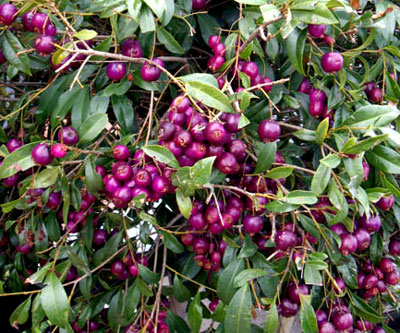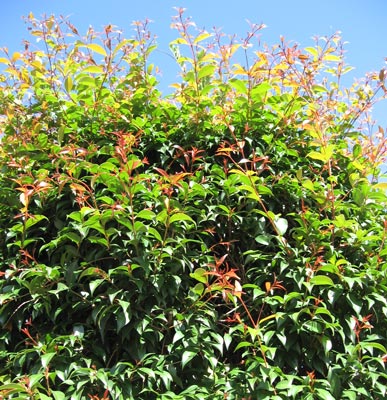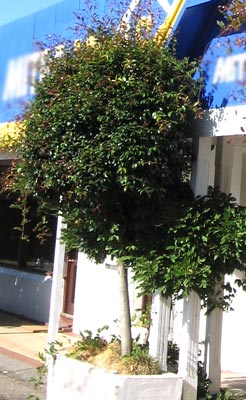Syzygium smithii (formerly Acmena smithii)
Lilly Pilly
The Lilly Pilly is a versatile evergreen with purple fruits native to the north-east of Australia.
|
| Features: |
Versatility in form - tree or hedge. Persistant glossy foliage and attractive coloured fruits. |
| Applications: |
Hedgerows, screening, streetscapes, specimen tree |
| Description |
Fomerly Acmena smithii, this adaptable tree is seen in gardens and landscapes in various forms - either pruned as hedges or screening, or left to grow to its natural, upright tree form. While its preference for richer clay soils and intolerance to drought might preclude it from some WA sites, the Lilly Pilly is still seen happily growing in suburban Perth gardens and in regional and coastal towns of the south-west. Its versatility in form makes it a useful plant for certain sites with its dense lustrous foliage and attractive pink or mauve fruits. Pruned for screening or hedging the near-ground growth will persist, but left to grow naturally it can mature into an attractive upright tree with a potentially dense canopy. |
| Availability: |
45L |
| Mature height: |
5-15 |
| Mature spread: |
5-10 |
| Canopy: |
Various, naturally broadly oval. Can be hedged. Moderate to dense shade depending on form and shape. |
| Growth rate: |
Fast in suitable conditions, otherwise moderate. |
| Cautions: |
Not drought tolerant. Not suitable for poor drying soils. Fruits autumn/winter. Fruits self-set readily. |
| Tolerances: |
Generally hardy in suitable sites. Range of climates from temperate to tropical. |
| Sun demands: |
Enjoys good sun but tolerates part shade. |
| Soil demands: |
Heavier clay soils. Avoid poor and drying soils. |
| Water demands: |
Moderate |
| WA Waterwise |
Visit Website |
| Native or Exotic: |
Native |
| Leaf habit: |
Evergreen |
| Family: |
Myrtaceae |
| |
|
|





|
Back to Search
Additional references and recommended reading:
Boland, D. J. et al (2006) "Forest Trees of Australia" 5th Edition, Australia: CSIRO Publishing.
Gilman, Edward F. (1997) "Trees for Urban and Suburban Landscapes", Florida: Delmar Cengage Learning.
Lorenz von Ehren "Von Ehren Manual" 2nd Edition, Hamburg.
Rushforth, K. (2001) "Easy Tree Guide, Britain and Europe", London: Aurum Press.
Urban Forests Ecosystems Institute, "SelecTree - A Tree Selection Guide" retrieved from http://selectree.calpoly.edu/treelist.lasso 2009.
Disclaimer:
Torbay Treefarmers makes all information on this website available in good faith to customers, based on experience, general knowledge and research and in so doing, makes no guarantee in any way about the accuracy or usefulness of this information, nor is any warranty made or inferred by the supply of this information, nor can Torbay Treefarmers be held responsible or accountable for any loss, harm or damage that may arise from the use or availability of any information on this website.
|